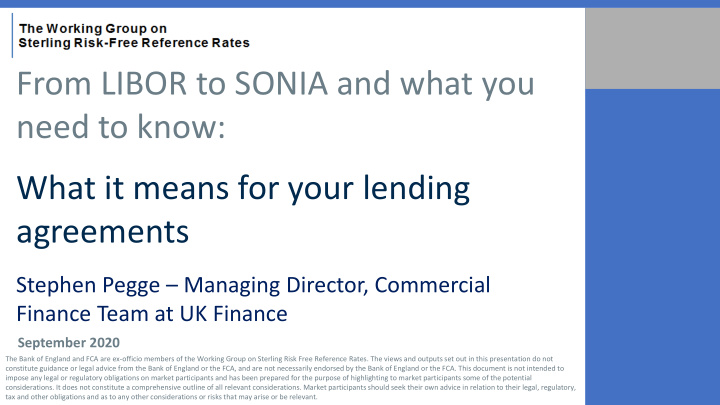



From LIBOR to SONIA and what you need to know: What it means for your lending agreements Stephen Pegge – Managing Director, Commercial Finance Team at UK Finance September 2020 The Bank of England and FCA are ex-officio members of the Working Group on Sterling Risk Free Reference Rates. The views and outputs set out in this presentation do not constitute guidance or legal advice from the Bank of England or the FCA, and are not necessarily endorsed by the Bank of England or the FCA. This document is not intended to impose any legal or regulatory obligations on market participants and has been prepared for the purpose of highlighting to market participants some of the potential considerations. It does not constitute a comprehensive outline of all relevant considerations. Market participants should seek their own advice in relation to their legal, regulatory, tax and other obligations and as to any other considerations or risks that may arise or be relevant.
Existing lending agreements What to check for when looking at your existing contracts 1. Check which of your lending or other agreements have LIBOR exposure , which currencies these cover and when they will mature . 2. Look to see if these agreements already contain ‘ fallbacks ’ setting out what will happen at the point LIBOR becomes unavailable. If they DO contain ‘fallbacks’: If they DON’T contain ‘fallbacks’: These may not be adequate for a scenario in Your lender will need to contact you to outline which LIBOR is permanently unavailable. options and agree how your contract could be amended to transition to an alternative rate Your lender is likely to still contact you to agree ahead of LIBOR becoming unavailable. how to proactively amend your contract before LIBOR becomes unavailable. ‘Fallbacks’ in legacy contracts are useful but should not necessarily be relied upon as the primary route to transition. The RFR Working Group encourages the active transition of existing contracts where possible . RFRWG Video Series: Introduction to LIBOR transition educational videos – September 2020
Existing lending agreements The RFR Working Group’s 5 key steps for the ‘Active transition of Sterling LIBOR referencing loans’ Step 1. Review outstanding GBP LIBOR referencing loans (including multi-currency loans containing a GBP LIBOR option). Step 2. Identify the alternative reference rate to be used for each loan (the industry working group have identified SONIA as the recommended replacement rate to Sterling Libor). Step 3. Familiarise yourself with how the alternative reference rate will be calculated, and how to calculate any economic difference between GBP LIBOR and the selected alternative reference rate. Step 4. Consider whether systems and operations are ready to accommodate alternative reference rates. Step 5. Document the transition of the loans. All parties should also undertake appropriate due diligence on any changes that are proposed – ask your bank what preparations they are making and what that means for you/your business. RFRWG Video Series: Introduction to LIBOR transition educational videos – September 2020
Credit Spread Adjustment Components of £ LIBOR and SONIA Alternative rates, e.g. SONIA, and LIBOR are not economically equivalent as alternative rates do not include a credit component reflecting bank s’ lending costs. When transitioning a contract from LIBOR to an alternative rate, a credit spread is applied to account for this difference. It is designed to ensure a fair transition and prevent cost being transferred onto either party when the contract migrates to a new rate. For more information watch the video on ‘What is a Credit Spread Adjustment?’ RFRWG Video Series: Introduction to LIBOR transition educational videos – September 2020
New lending agreements What to look for You will increasingly be offered loans based on non-LIBOR rates, such as SONIA, from Q3 2020 onwards. The simplest way to not have to worry about new LIBOR-linked loans is to use alternative rates as they become available. For those continuing to take out loans linked to LIBOR, from Q3 this year : Loans will contain legal language agreeing how the contract will convert before LIBOR becomes unavailable, ideally setting out the alternative rate and effective date for the change. If this is not possible upfront, you will still need to work with your lender to contractually agree a process to revisit the loan agreement before end-2021 to negotiate these terms. This language will be in addition to ‘fallback mechanisms’ - designed to convert the contract at the point of LIBOR cessation or when it is deemed no longer representative. RFRWG Video Series: Introduction to LIBOR transition educational videos – September 2020
Key Conclusions 1. Now is the time to become familiar with what LIBOR Transition means for you and your lending agreements. Agreements which don’t foresee LIBOR ending are now a thing of the past and will need to be updated. 2. Lenders should offer lending agreements on non-LIBOR linked rates, such as SONIA, from Q3 2020 and cease LIBOR-linked lending from Q1 2021. 3. The more that is agreed up front in terms of setting out how this switch away from LIBOR will occur and to what rate, the less both lenders and borrowers will need to do in the crucial period at the end of 2021. 4. The credit spread adjustment is applied to achieve a fairer transition and avoid costs being transferred onto either party when a contract transitions away from LIBOR. 5. If in doubt, speaking with your lender is the simplest first step. RFRWG Video Series: Introduction to LIBOR transition educational videos – September 2020
Key resources on LIBOR Transition Prepare for conversations with your lender Discontinuation of LIBOR: UK Finance Guide for Business Customers 'Calling time on LIBOR Why you need to act now’ Factsheet Transition from LIBOR – FCA webpage Overnight Risk Free Rates: A User’s Guide – Financial Stability Board Educational videos - The Working Group on Sterling Risk-Free Reference Rates webpage RFRWG Video Series: Introduction to LIBOR transition educational videos – September 2020
Recommend
More recommend